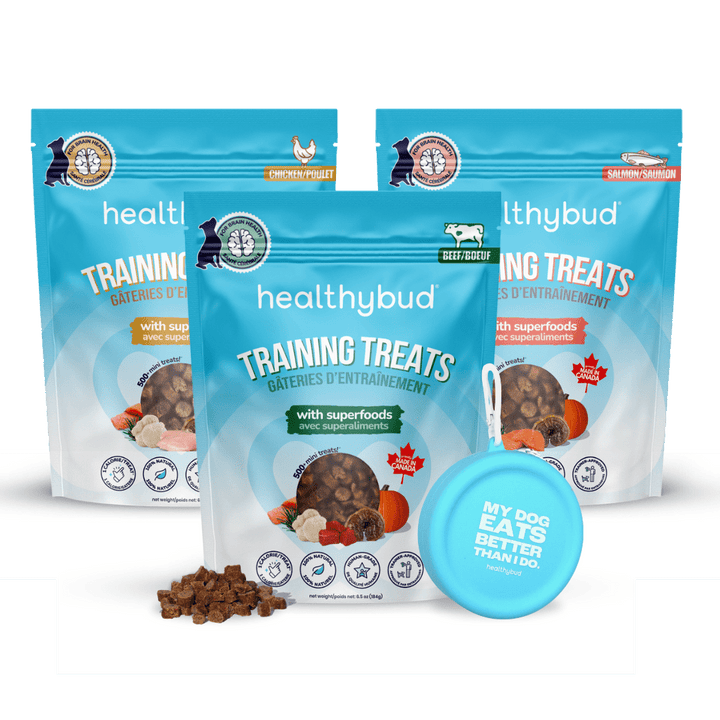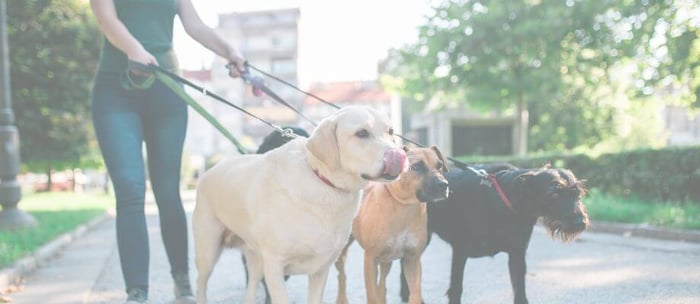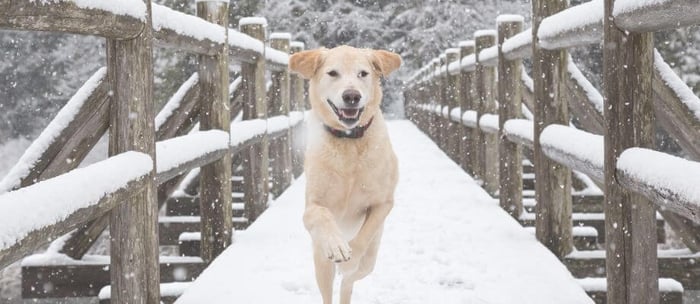Table of Contents
Summary ✍️
Food is one of the most powerful tools in dog training—when used properly. But with so many treat options out there, it’s easy to get overwhelmed. Should you use kibble? Freeze-dried raw? Something from your fridge? And, when it comes to training with food and treats, how much is too much? In this blog, we'll explain how to train dogs using food and treats.
We’ll break down the science and psychology of food-based training, why high-value rewards matter, and how to choose the right treats (including the difference between kibble and freeze-dried raw). We’ll also share expert-backed tips for success, Healthybud’s top training treat picks, and a special discount just for our readers.
Key Takeaways 🔑
Dogs are highly food-motivated, which makes food a powerful training reward.
Freeze-dried raw food often outperforms kibble due to higher value, palatability, and nutrition.
Use smaller portions and vary your rewards to keep your dog engaged and motivated.
Training sessions should be short, positive, and consistent—especially when using food.
Healthybud’s freeze-dried raw meal bites (turkey, beef) and mini training treats (chicken, salmon, beef) are both great options for positive reinforcement and keeping your pup excited to learn.
Training Treat Trio – Bundle & Save

$60.00 CAD
$67.00 CAD
All 3 bestselling flavours + a FREE Training Treat Pouch! Make training time smarter, healthier, and more fun with our Training Treat Variety Pack — a trio of our most popular 1-calorie superfood treats in Beef, Chicken & Wild-Caught Salmon. Each treat is… read more
What is food and treat-based dog training? 🦴
Food and treat-based dog training is one of the easiest (and most fun!) ways to teach your dog good habits. Food and treat-based training uses tasty rewards—like your dog’s favourite Healthybud snacks—to encourage positive behaviour. Every time your pup does something right (like sitting, staying, or coming when called), you reward them with a treat. That way, they learn to connect the good behaviour with something they love: food! Keep reading for more info on how to train dogs using food and treats.
Why Food-Based Dog Training Works ✅
Dogs are wired to respond to food. It’s primal, biological, and incredibly effective when paired with the right timing and technique. This concept is called positive reinforcement: you reward your dog with something they love (in this case, food) immediately after they perform a desired behaviour. Over time, this strengthens the behaviour, making it more likely your dog will repeat it.
Scientific studies and canine behaviourists agree: positive reinforcement is one of the most humane, effective, and lasting training methods available. It helps foster trust between you and your dog, encourages learning, and reduces fear-based behaviours.
While praise, toys, and playtime are all good forms of reinforcement, food remains the most consistently motivating reward—especially in distracting or high-stakes situations.
Freeze-Dried Raw vs. Kibble: What’s the Difference? 🍖
You might be tempted to reach for kibble when teaching your pup new tricks. It’s convenient, bite-sized, and probably already sitting in your pantry if it’s part of your dog’s diet. But not all food is created equal—especially when it comes to training.
Here’s the thing: kibble is often made with high heat, fillers, and synthetic additives that strip away nutrients and can be tough on your dog’s digestion. Plus, dogs tend to find it... well, boring.
Sure, kibble might work for simple cues in a quiet environment—but when your dog is distracted, unmotivated, or learning something new, you’ll need something more exciting to get (and keep!) their attention. And if you’re spending a lot of time training—which means your bud is eating a lot of rewards—it’s worth choosing something more nutritious, too.
That’s where freeze-dried raw food really shines.
Freeze-Dried Raw Treats: High-Value Training Fuel
Freeze-dried raw treats are made by gently removing moisture from raw ingredients—like meat, organs, or fish—without cooking them. This process retains nearly all of the food’s nutritional value and aroma, making it incredibly appealing to dogs.
Dogs tend to go wild for freeze-dried raw food and treats because they smell and taste closer to what their ancestors would naturally crave. And because they’re minimally processed, they’re typically easier to digest and less likely to trigger sensitivities.
From a training perspective, freeze-dried raw treats are considered “high-value rewards.” These are the kinds of treats your dog will do anything for. You’ll want to keep them in your pocket for difficult commands, new environments, or moments when you really need their attention.
Healthybud’s freeze-dried raw food products—like our Turkey Meal Bites and Beef Meal Bites—are protein-packed, irresistible, and shaped just like kibble, so they’re already the perfect bite-sized pieces for training.
Even though they’re technically complete and balanced meals, their size and texture make them super easy to use just like a treat.
Turkey Meal Bites

$48.00 CAD
Raw nutrition. Advanced gut support. Kibble convenience. A one-of-a-kind formulation with butcher quality meat and pre+postbiotics for smoother digestion – all in a crunchy, irresistible bite! Great For:✓ Sensitive stomachs + picky dogs✓ Improved digestion & stool quality✓ Raw feeding… read more
Kibble: Familiar but Lower-Value
Kibble, on the other hand, is a lower-value food reward. If your dog eats it every day, it definitely doesn't carry the same novelty or excitement as something more unique. It also tends to be more processed and less aromatic, which can reduce its appeal—especially if you’re asking your dog to focus in a stimulating or challenging environment.
That said, kibble can still be useful if you have a pup that is highly food-motivated no matter the treat, particularly when reinforcing behaviours your dog already knows or in calm settings like your living room.
But even then, if you're looking for a nutritional boost to support your dog’s health and energy throughout the training process, kibble can’t compare to freeze-dried raw.
When to Use High-Value Treats 🦮
Just like us, dogs appreciate variety. And just like us, they’re more likely to put in the effort for something they really want. That’s why professional dog trainers recommend using a reward hierarchy—where you choose different types of treats based on the difficulty of the task or the context of the behaviour.
Low-value treats (like kibble or dry biscuits) are fine for easy cues in calm environments (like “sit” at home).
Medium-value treats (like simple, single-ingredient banana chip treats) are great for intermediate tasks or new tricks.
High-value treats (like homemade meat, freeze-dried raw or hearty beef lung treats) should be reserved for the toughest tasks: leash reactivity, off-leash recall, vet visits, or training in public.
By saving your highest-value rewards for the most challenging work, you’ll boost your chances of success and avoid “devaluing” the treats over time.
That said, variety is key. While freeze-dried raw treats are a game-changer for tough training sessions, it’s important to mix things up with other high-quality treats to keep your dog engaged and excited.
For example, Healthybud's Mini Training Treats offer a delicious, convenient, low-calorie alternative with brain-boosting superfood ingredients that keep your bud energized and focused during training sessions.
Variety not only keeps your dog motivated but also ensures they're getting a well-rounded experience with different textures and flavours.
Beef Lung Wafers

$12.00 CAD
The ultimate high-reward treat for picky dogs.These lightweight, single-ingredient wafers are packed with protein, iron, and essential nutrients to help support strong muscles and bones. Gently baked for a crunchy texture dogs love, they’re easy to break apart, making them… read more
Healthybud’s Top Training Treat Picks 👀
When thinking about how to train dogs using food and treats, it's important to consider which food and treats you choose. Check out our top picks for nutritious, high-quality treats that’ll keep your pup focused and motivated through every step of their training journey.
Mini Training Treats ('Functional Dog Treat of the Year,' Pet Innovation Awards)
Packed with brain-boosting superfoods like Lion’s Mane, Reishi, and Salmon Oil, these tiny, trainer-approved treats support cognitive function and immunity to keep your pup motivated and focused during training. With over 500 treats per bag, only 1 calorie each, and three delicious flavours, they’re the perfect healthy reward, made with 100% natural ingredients and no artificial additives.Freeze-Dried Raw Turkey or Beef Meal Bites
When you need something irresistible to capture your dog’s attention, these freeze-dried raw meal bites are your go-to. Packed with nutrients and bursting with natural flavour, they’re perfect for more complex tasks, like off-leash recall or leash reactivity. Keep them on hand for those tricky moments when you need to raise the stakes! Bonus: Despite being bite-sized treats, full portions make for complete and balanced meals at mealtime.Air-Dried Beef Lung Wafers
If you're looking for something truly high-value and irresistible, our freeze-dried beef lung is perfect for getting your dog’s full attention during advanced training. These treats are packed with protein and rich in natural flavour, making them ideal for tough tasks like recall in challenging environments or leash reactivity. They’re lightweight, easy to carry, and can be broken into small pieces for training on the go.
Training Tips for Food-Based Rewards 🎯
Now that you know what kinds of treats to use, here’s how to use them effectively:
- Keep it small: The best training treats are soft and tiny—about the size of a pea. You want your dog to get the reward quickly and be ready to move on to the next rep without needing to chew for ages.
- Timing is everything: Reward your dog immediately after the behaviour. If you wait too long, they might associate the treat with something else (like barking or sitting down again).
- Be consistent: Train regularly in short, focused sessions—5 to 10 minutes is ideal. Consistency helps your dog understand what’s expected and speeds up learning.
- Use the 80/20 rule: Once your dog has learned a cue, you don’t need to give a treat every time. Reward about 80% of the time and switch it up with praise, pets, or a toy. This keeps your dog guessing and more motivated (just like a slot machine!).
- Choose the right environment: Start in a quiet, familiar space, then gradually add distractions as your dog improves. Use your highest-value treats when training in new or chaotic settings.
Expert Vet Advice: How to Train Dogs Using Food 👩🏽⚕️
According to a VCA Animal Hospitals article by the Canadian Academy of Veterinary Nutrition (CAVN) and Sarah Wilson, BScH, DVM, DACVIM (Nutrition), vets recommend keeping treats to just 10% of your dog’s total daily calorie intake during training.
“It is important to keep calories from treats within 10% of your dog’s total calorie intake to prevent excessive nutrient intake and to help prevent deficiencies. So, if your dog eats about 550 calories per day, then 495 calories should come from a complete and balanced diet appropriate for your dog’s life stage, and 55 calories can come from treats,” the article says.“The easiest way to avoid over-treating is by measuring out treats and ensuring that you stay within your dog’s 10% allowance. If feeding commercial treats, check how many calories each treat provides and set aside exactly the correct amount.”
If feeding whole foods, they recommend finding general calorie counts specified by the USDA FoodData Central food database online and estimating how many calories your treats provide to ensure you stay within the 10% treat allowance.
What does 10% look like?
5 grams of air-popped popcorn
10 grams of raw green beans
20 grams of apple or banana50 grams of boiled carrots
Safe foods include: apples, cheese, cooked eggs, lettuce, carrots, zucchini, green beans, de-strung celery, pasta, blueberries, strawberries, raspberries, seedless watermelon, cooked meats, and cooked seafood.
On the other hand, you should avoid toxic foods, such as: alcohol, chocolate, macadamia nuts, garlic, onions, grapes, raisins, salty snack foods, high-fat snacks, moldy cheeses, and any food with xylitol artificial sweetener such as some peanut butters.
FAQs: How to Train Dogs Using Food and Treats 🔍
📣 Can I train my dog using only kibble?
💬 You can, but results may vary. Kibble might work for simple cues in calm settings, but for advanced training, freeze-dried raw or high-value treats are more effective—and more nutritious, which matters when your pup’s getting lots of rewards.
📣 How many treats is too many during a training session?
💬 Stick to small pieces and watch your dog’s overall caloric intake. You can even subtract treat calories from their meals or use low-calorie options like Healthybud’s Mini Training Treats.
📣 Can puppies be trained with freeze-dried raw treats?
💬 Absolutely! Freeze-dried raw treats are especially useful for puppies who are learning new cues quickly and need strong motivation. Just choose puppy-safe options and break them into very small pieces.
Conclusion 🚀
Training your dog doesn’t have to be a chore—it can be an exciting opportunity to connect, communicate, and have fun. And food is one of the most powerful ways to reinforce those positive experiences.
By choosing high-value, healthy treats like freeze-dried raw food, you’ll not only see faster progress in training but also give your dog the nutrition they deserve.
So whether you’re teaching “sit” or working on leash manners, don’t underestimate the power of a tiny, tasty reward. And remember: your dog wants to make you proud—they just need the right motivation to do it.
Beef Meal Bites

$48.00 CAD
Raw nutrition. Advanced gut support. Kibble convenience. A one-of-a-kind formulation with butcher quality meat and pre+postbiotics for smoother digestion – all in a crunchy, irresistible bite! Great For:✓ Sensitive stomachs + picky dogs✓ Improved digestion & stool quality✓ Raw feeding… read more
🚨 Special Promo Alert!
As a thank you for reading our blog, enjoy a 15% discount on all Healthybud products! Use code BLOG15 at checkout.
Author Bio:
 Brian Benson has been training his own dogs since he was a kid, turning a passion into a lifelong skill. After he adopted @magnusthetherapydog, he worked to build a solid training foundation: Brian started with basic obedience and progressed into trick training, therapy dog work, service dog skills, and even nose work winning multiple trials in scent detection with Magnus by his side.
Brian Benson has been training his own dogs since he was a kid, turning a passion into a lifelong skill. After he adopted @magnusthetherapydog, he worked to build a solid training foundation: Brian started with basic obedience and progressed into trick training, therapy dog work, service dog skills, and even nose work winning multiple trials in scent detection with Magnus by his side.
With a community of millions of dog lovers on social media, Brian realized that a lot of people wanted to know how Magnus is so incredibly well trained so he created a FREE dog training community to help people train their own dogs at home.






